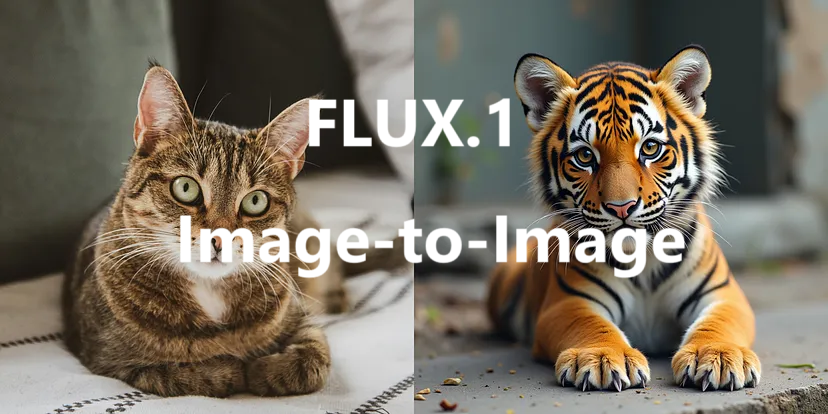FLUX.1 图生图原理及实践
本文介绍扩散模型的工作原理,学习如何修改反向扩散过程以根据文本提示编辑图像,最后提供实现代码。

这篇文章将指导你根据现有图像和文本提示生成新图像。这项技术在一篇名为《SDEdit:使用随机微分方程进行引导图像合成和编辑》的论文中提出,并在此应用于 FLUX.1。
首先,我们将简要解释潜在扩散模型的工作原理。然后,我们将了解 SDEdit 如何修改反向扩散过程以根据文本提示编辑图像。最后,我们将提供运行整个管道的代码。
1、背景:潜在扩散
潜在扩散在低维潜在空间中执行扩散过程。让我们定义潜在空间:

变分自动编码器 (VAE) 将图像从像素空间(人类理解的 RGB 高度宽度表示)投影到较小的潜在空间。这种压缩保留了足够的信息以便稍后重建图像。扩散过程在此潜在空间中运行,因为它在计算上更便宜,并且对不相关的像素空间细节不太敏感。
现在,让我们解释一下潜在扩散:

扩散过程分为两部分:
- 前向扩散:一种预定的、非学习的过程,通过多个步骤将自然图像转换为纯噪声。
- 后向扩散:一种学习过程,从纯噪声重建自然图像。
请注意,噪声被添加到潜在空间并遵循特定的时间表,在前向过程中从弱到强。
噪声按照特定的时间表添加到潜在空间,在前向扩散过程中从弱噪声逐渐变为强噪声。与 GAN 等一次性生成方法相比,这种多步骤方法简化了网络的任务。反向过程是通过似然最大化来学习的,这比对抗性损失更容易优化。
文本条件

图像生成还取决于文本等额外信息,这是你可能提供给稳定扩散或 Flux.1 模型的提示。在学习如何进行反向过程时,此文本作为扩散模型的“提示”包含在内。此文本使用类似 CLIP 或 T5 模型的模型进行编码,并输入到 UNet 或 Transformer 中,以将其引导至受噪声干扰的正确原始图像。
2、SDEdit
SDEdit 背后的想法很简单:在反向过程中,它不是像上图的“步骤 1”那样从完全随机噪声开始,而是从输入图像 + 缩放的随机噪声开始,然后再运行常规的反向扩散过程。因此,它如下:
- 加载输入图像,为 VAE 进行预处理
- 通过 VAE 运行它并采样一个输出(VAE 返回一个分布,因此我们需要采样来获取分布的一个实例)。
- 选择反向扩散过程的起始步骤 t_i。
- 采样一些缩放到 t_i 级别的噪声并将其添加到清晰图像表示中。
- 使用嘈杂的清晰图像和提示从 t_i 开始反向扩散过程。
- 使用 VAE 将结果投影回像素空间。
- 成功!
3、代码实现
以下是使用diffusers运行此工作流程的方法:
首先,安装依赖项:
pip install git+https://github.com/huggingface/diffusers.git optimum-quanto目前,你需要从源代码安装diffusers,因为此功能在 pypi 上尚不可用。
接下来,加载 FluxImg2Img 管道 :
import os
from diffusers import FluxImg2ImgPipeline
from optimum.quanto import qint8, qint4, quantize, freeze
import torch
from typing import Callable, List, Optional, Union, Dict, Any
from PIL import Image
import requests
import io
MODEL_PATH = os.getenv("MODEL_PATH", "black-forest-labs/FLUX.1-dev")
pipeline = FluxImg2ImgPipeline.from_pretrained(MODEL_PATH, torch_dtype=torch.bfloat16)
quantize(pipeline.text_encoder, weights=qint4, exclude="proj_out")
freeze(pipeline.text_encoder)
quantize(pipeline.text_encoder_2, weights=qint4, exclude="proj_out")
freeze(pipeline.text_encoder_2)
quantize(pipeline.transformer, weights=qint8, exclude="proj_out")
freeze(pipeline.transformer)
pipeline = pipeline.to("cuda")
generator = torch.Generator(device="cuda").manual_seed(100)此代码加载管道并量化其中的某些部分,以便它适合 Colab 上可用的 L4 GPU。
现在,让我们定义一个实用函数来加载正确大小且不失真的图像:
def resize_image_center_crop(image_path_or_url, target_width, target_height):
"""
Resizes an image while maintaining aspect ratio using center cropping.
Handles both local file paths and URLs.
Args:
image_path_or_url: Path to the image file or URL.
target_width: Desired width of the output image.
target_height: Desired height of the output image.
Returns:
A PIL Image object with the resized image, or None if there's an error.
"""
try:
if image_path_or_url.startswith(('http://', 'https://')): # Check if it's a URL
response = requests.get(image_path_or_url, stream=True)
response.raise_for_status() # Raise HTTPError for bad responses (4xx or 5xx)
img = Image.open(io.BytesIO(response.content))
else: # Assume it's a local file path
img = Image.open(image_path_or_url)
img_width, img_height = img.size
# Calculate aspect ratios
aspect_ratio_img = img_width / img_height
aspect_ratio_target = target_width / target_height
# Determine cropping box
if aspect_ratio_img > aspect_ratio_target: # Image is wider than target
new_width = int(img_height * aspect_ratio_target)
left = (img_width - new_width) // 2
right = left + new_width
top = 0
bottom = img_height
else: # Image is taller or equal to target
new_height = int(img_width / aspect_ratio_target)
left = 0
right = img_width
top = (img_height - new_height) // 2
bottom = top + new_height
# Crop the image
cropped_img = img.crop((left, top, right, bottom))
# Resize to target dimensions
resized_img = cropped_img.resize((target_width, target_height), Image.LANCZOS)
return resized_img
except (FileNotFoundError, requests.exceptions.RequestException, IOError) as e:
print(f"Error: Could not open or process image from '{image_path_or_url}'. Error: {e}")
return None
except Exception as e: #Catch other potential exceptions during image processing.
print(f"An unexpected error occurred: {e}")
return None最后,让我们加载图像并运行管道:
url = "https://images.unsplash.com/photo-1609665558965-8e4c789cd7c5?ixlib=rb-4.0.3&q=85&fm=jpg&crop=entropy&cs=srgb&dl=sven-mieke-G-8B32scqMc-unsplash.jpg"
image = resize_image_center_crop(image_path_or_url=url, target_width=1024, target_height=1024)
prompt = "A picture of a Tiger"
image2 = pipeline(prompt, image=image, guidance_scale=3.5, generator=generator, height=1024, width=1024, num_inference_steps=28, strength=0.9).images[0]这将下面的图像:

转换为:

你可以看到,这只猫的姿势和形状与原始猫相似,但地毯颜色不同。这意味着模型遵循与原始图像相同的模式,同时也采取了一些自由度,使其更适合文本提示。
这里有两个重要的参数:
- num_inference_steps:它是向后扩散过程中去噪步骤的数量,数字越大意味着质量越好,但生成时间越长
- strength:强度,它控制你想要在扩散过程中开始多少噪音或多远。数字越小意味着变化越小,数字越大意味着变化越大。
4、结束语
现在你知道了图像到图像潜在扩散的工作原理以及如何在 Python 中运行它。在我的测试中,使用这种方法的结果仍然可能参差不齐,我通常需要更改步骤数、强度和提示,以使其更好地遵循提示。下一步将研究一种具有更好的及时遵守性同时保留输入图像的关键元素的方法。
原文链接:Image-to-Image Translation with FLUX.1: Intuition and Tutorial
汇智网翻译整理,转载请标明出处
